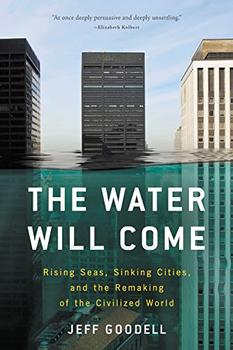Summary | Excerpt | Reviews | Beyond the Book | Readalikes | Genres & Themes | Author Bio

Rising Seas, Sinking Cities, and the Remaking of the Civilized World
by Jeff Goodell1 . THE OLDEST STORY EVER TOLD
The R/V Knorr was a storied ship in the annals of science, known for its ability to take a pounding in rough seas and its unusual arrangement of propellers in the bow and stern that made it highly maneuverable. Scientists had used the Knorr, a 244 -foot steel-hulled research vessel that was operated by Woods Hole Oceanographic Institution, for thousands of research expeditions around the world, including one that led to the discovery of the wreck of the RMS Titanic. A few years ago, I spent a month aboard the Knorr. On my trip, we were looking for nothing more glamorous than good, thick mud on the floor of the North Atlantic. By drilling cores in the mud and analyzing the shells of creatures buried within it, researchers can better understand past ocean temperature and salinity, which are important as scientists attempt to reconstruct the history of the Earth's climate.
Most of our time was spent cruising around the Bermuda Rise, a cluster of extinct underwater volcanos near Bermuda, pausing to take core samples of the mud whenever the conditions looked good. At one point, we were about a hundred miles off the coast of New York City when we drifted over a place known to scientists as the Hudson Canyon, which is where the Hudson River used to drop over the continental shelf twenty thousand years ago when seas were lower. From the ship, a device called an acoustic echo machine painted colorful real-time images of the canyon as we passed over it. It was a remarkable sight: you could see where the Hudson had cut a path through the shelf, creating terraces and high walls. The canyon extends over 450 miles across the shelf, eventually reaching a depth of over 10,000 feet. "It's bigger than the Grand Canyon," Lloyd Keigwin, the chief scientist on the trip, told me as I looked down in wonder.
Twenty thousand years ago, near the peak of the last ice age, the world was a very different place than it is today. Temperatures were about seven degrees Fahrenheit cooler and the climate was, in most places, drier. In North America, all the ice-age creatures we know and love from Ice Age, the movie — mammoths, sloths, saber-toothed tigers — roamed through the plains and forests. In the West, you could walk from what's now San Francisco to the Farallon Islands. The Laurentide ice sheet, thousands of feet thick in places, covered most of Canada and the Upper Midwest and spread along the East Coast all the way to New York City. In Europe, it was dry land from London to Paris, and up north, from Scotland all the way over to Sweden. In Asia, you could walk from Thailand to Indonesia, and then take a boat down to Australia.
And people did. One wave of migration, as every American kid learns in middle school, brought humans across the land bridge between Asia and North America, thus laying the groundwork for the birth of Hollywood, Silicon Valley, and Ben & Jerry's ice cream. Exactly why and when human beings made the trip across the land bridge in the first place is much debated. Until recently, the best guess for the date of the arrival of humans in North America was 13,200 years ago. Many anthropologists believed it couldn't have been much earlier than that because although the land bridge was open, much of North America was covered in an ice sheet until then, making it virtually impossible for even the most intrepid early explorers to travel down into the interior of the continent.
But that narrative has been challenged. In 2012, Jessi Halligan, a young anthropologist at Florida State University, led a team of divers to explore the Aucilla River about seventy-five miles from Tallahassee. The Aucilla is a slow, dark, mysterious river that winds across northern Florida's limestone plateau toward the Gulf of Mexico. Earlier archaeologists had pulled up boatloads of bison bones, saber-toothed tiger bones, and mastodon bones and tusks, some with markings that looked like humans could have made them. During the ice age, the sea had met the land a hundred miles farther out, and the area where the Aucilla now flows was high savannah. Springwater bubbled and pooled in the limestone, creating watering holes where animals gathered to drink. As the seas rose and the water backed up, these watering holes filled with sediment, covering and preserving the bones of the animals that had died along the waterholes.
Excerpted from The Water Will Come Copyright © 2017 by Jeff Goodell. Used with permission of Little, Brown and Company, New York. All rights reserved.






Your guide toexceptional books
BookBrowse seeks out and recommends the best in contemporary fiction and nonfiction—books that not only engage and entertain but also deepen our understanding of ourselves and the world around us.